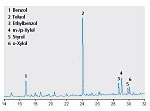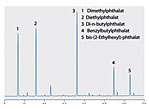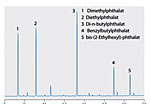Air and gas monitoring
Thermal desorption is ideally suited for determination of air toxics and other volatile organic compounds, such as solvents or ozone precursors, e.g. for occupational health and safety monitoring and for process control or pollution monitoring.
A typical example shows the monitoring of benzene, toluene and xylene in air. These components are particularly injurious to human health due to their toxicity and their carcinogenic nature.
Analysis of solid samples
Solids can easily be analyzed by applying thermal desorption. For determination of organic compounds the sample is simply filled into a sample tube. No additional sample preparation will be required.
The chromatogram shows an application from the pharmaceutical industry. For production control and QA/QC purposes the concentration of solvent residues in tablets can easily be determined by means of thermal desorption.
Test chamber and stripping methods
Evaporations e.g. from foams, adhesives, floor coverings, elastomers, plastics or molding materials can be determined by the use of test chamber methods. At well defined conditions an aliquot air sample will be taken from the chamber for subsequent analysis by means of thermal desorption.
The example chromatogram shows the examination of evaporated plasticizers from polymers in a test chamber.
Stripping methods work in a similar way. The volatile organic compounds will be stripped out using a carrier gas and collected on a sample tube for subsequent thermal desorption and GC analysis.


